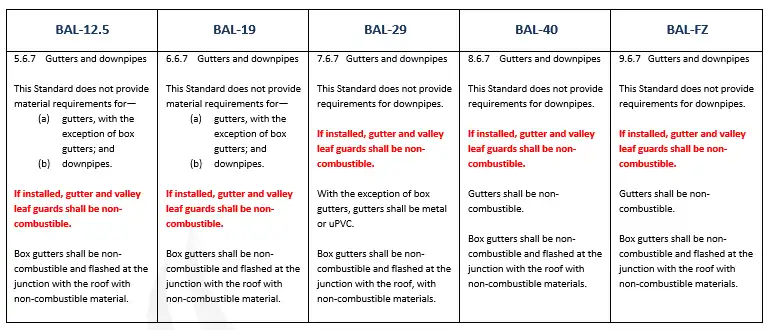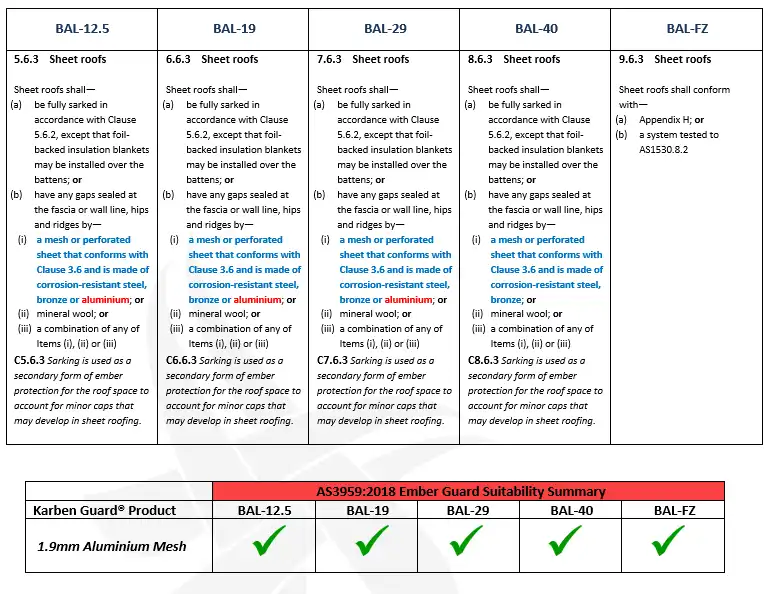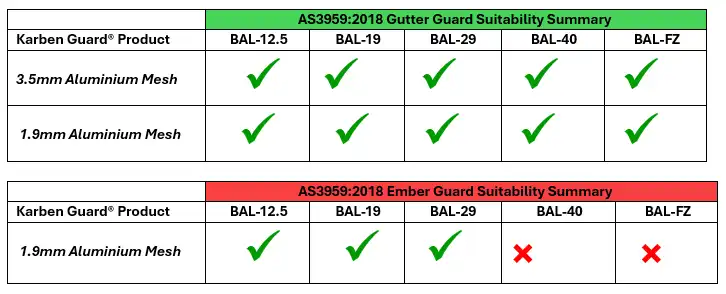Australian Standards & Product Compliance
See us in action
Australian Standard For Building In Bushfire Prone Areas (AS3959) Explained.
The Australian Standard for building in a bushfire prone area (AS3959:2018) places only one restriction on gutter guard regardless of the Bushfire Attack Level (BAL). (see extract below)
“If installed, gutter and valley leaf guards shall be non-combustible”

To determine if a material is non-combustible, it must be tested in accordance with AS 1530.1, however any product which has a paint coating over a metal base would not pass AS 1530.1, as that small amount of combustible material would be enough to fail the test. There is a clause in the Building Code of Australia (BCA) that allows finishes of less than 1 mm thickness over metal substrates, provided the finished product achieves a ‘Spread of Flame index’ not greater than 0 when tested to AS/NZS 1530.3.
Our aluminium gutter mesh has been tested in accordance with AS 1530.3 and achieved a spread of flame index of 0 (test result available on request) and for the purpose of compliance therefore deemed “non-combustible”

AS3959:2018 defines Ember guard as “A cover inserted in or over an opening or cavity to prevent the entry of burning embers.” Referenced in Clause 3.6 VENTS, WEEPHOLES, GAPS AND SCREENING MATERIALS, “The maximum allowable aperture size of any mesh or perforated material used as a screen shall be 2 mm.

One of the most common areas we are asked to supply ember guard for is to address the underside of roof corrugations, however, this is more commonly addressed with the use of appropriate blanket and foil/ insulation products.
It is important to note that ember guard can be non-combustible material (like BAL suitable blanket and foil) or a mesh or perforated sheet with a maximum aperture of 2 mm, made of corrosion-resistant steel, bronze (or aluminium for BAL-12.5 BAL-19 & BAL-29).
NCC 2022 – Roof Space Condensation Management.
A more common area Karben Guard® 1.9mm Ember Guard is used, relates to ventilation gaps required to help mitigate condensation in roof spaces for both high and low level roof ventilation openings. The product can be used under ridge capping and roof sheeting as well as in eave ventilation systems in BAL-12, BAL-19 and BAL-29.
Other areas where mesh type ember guards are more commonly used include;
- Roof ventilation systems and whirlybirds.
- Weep holes in brickwork.
4) Enclosed subfloor spaces of verandas, decks, steps, ramps and landings.
5) External single pane glazed elements of roof lights and skylights, where the pitch of the glazed element is 18 degrees or less to the horizontal.
There are several building industry produced documents that identify how to address the various ember guarding requirements associated with the products they supply.
These include
- National Association of Steel Framed Housing (NASH) – Bushfire design and detailing
- BlueScope Steel – Product Solutions for Bushfire Areas
- Bradford – Bushfire Roofing System Design Guide
- James Hardie – Technical Supplement, Construction of buildings in bushfire prone areas to AS 3959:2018
History
Australia has a long history of bushfires endangering properties all across the country. Protecting existing, established homes from the onset of bushfire attacks was and still is the responsibility of the owner or occupier. In more recent times the state fire authorities have published recommendations for how to best prepare for bushfire attacks and all of them indentify the importance of ensuring the roof guttering systems are clear and free of leaf litter and debris. Some state fire authorities go a step further and also suggest that “quality metal leaf guards” be fitted.
For many years these recommendations were the only place gutter or leaf guards were mentioned.
When things began to change was in the late 1990’s. Regions which were identified to be at an increased level of risk of bushfire attack were deemed to be “Bushfire Prone Areas”. Recommendations were heard regarding the potential benefits of addressing bushfires at a construction and design level and in 1999 The Australian Standard for building in bushfire prone areas (AS3959-1999) was released. This standard indentified five (5) risk levels of bushfire attack and included 3 separate construction levels. These construction levels placed specific requirements on the building products to be used in the construction of any new dwelling (or major renovation of an existing dwelling). The only reference to gutter guard in this standard stated;
“Any device used to stop leaves collecting in the gutters shall have a flammability index of not greater than 5 when tested in accordance with AS 1530.2.”
In March of 2009 a third edition of AS3959 was released and superseded AS3959-1999. AS3959-2009 incorporated a few changes including the method of determining the Bushfire Attack Level (BAL) for a site, and now comprised six categories, namely BAL-LOW, BAL-12.5, BAL-19, BAL-29, BAL-40 and BAL-FZ (flame zone).
These six categories determine what construction and design requirements are placed on any new construction or renovation, to be undertaken in areas identified as bushfire prone.
In November 2018 a new standard was released making AS3959-2018 the current Australian Standard for which gutter guard needs to comply with.
In addition to the requirements of The Australian Standard For Building In Bushfire Prone Areas, relevant local councils and state fire authorities may also add conditions as part of development applications (DA) for construction or land subdivisions.


